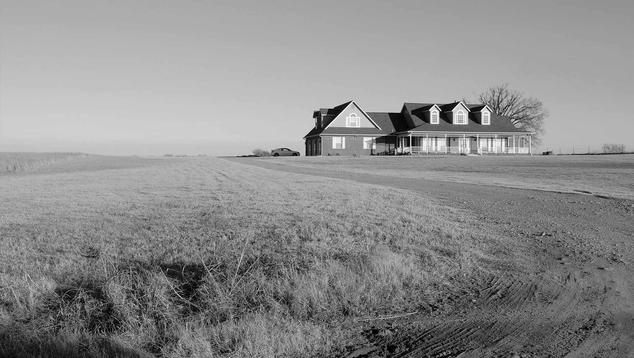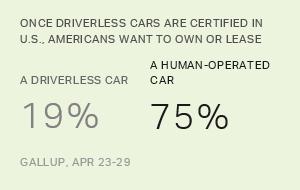Story Highlights
- 27% of Americans would like to live in a rural area; 12% in a big city
- The appeal of rural areas is highest among those 50 and older
- Young millennials' preference is to live in a big-city suburb
WASHINGTON, D.C. -- Given six choices of a type of place where they could live, 27% of Americans choose a rural area, more than any other option -- although this is down from 35% in 2001. Another 21% currently favor life in a suburb of a big city, while 12% would choose a big city itself. The remaining 39% would choose a town, a small city or a suburb of a small city.
| 2001 Oct 19-21 | 2018 Nov 13-18 | ||||||||||||||||||||||||||||||||||||||||||||||||||||||||||||||||||||||||||||||||||||||||||||||||||
|---|---|---|---|---|---|---|---|---|---|---|---|---|---|---|---|---|---|---|---|---|---|---|---|---|---|---|---|---|---|---|---|---|---|---|---|---|---|---|---|---|---|---|---|---|---|---|---|---|---|---|---|---|---|---|---|---|---|---|---|---|---|---|---|---|---|---|---|---|---|---|---|---|---|---|---|---|---|---|---|---|---|---|---|---|---|---|---|---|---|---|---|---|---|---|---|---|---|---|---|
| % | % | ||||||||||||||||||||||||||||||||||||||||||||||||||||||||||||||||||||||||||||||||||||||||||||||||||
| Big city | 8 | 12 | |||||||||||||||||||||||||||||||||||||||||||||||||||||||||||||||||||||||||||||||||||||||||||||||||
| Small city | 15 | 17 | |||||||||||||||||||||||||||||||||||||||||||||||||||||||||||||||||||||||||||||||||||||||||||||||||
| Suburb of a big city | 20 | 21 | |||||||||||||||||||||||||||||||||||||||||||||||||||||||||||||||||||||||||||||||||||||||||||||||||
| Suburb of a small city | 9 | 10 | |||||||||||||||||||||||||||||||||||||||||||||||||||||||||||||||||||||||||||||||||||||||||||||||||
| Town | 12 | 12 | |||||||||||||||||||||||||||||||||||||||||||||||||||||||||||||||||||||||||||||||||||||||||||||||||
| Rural area | 35 | 27 | |||||||||||||||||||||||||||||||||||||||||||||||||||||||||||||||||||||||||||||||||||||||||||||||||
| GALLUP | |||||||||||||||||||||||||||||||||||||||||||||||||||||||||||||||||||||||||||||||||||||||||||||||||||
These results are from Gallup interviewing conducted Nov. 13-18, updating a question initially asked in October 2001. Respondents are offered six choices of where they would live if they could live anywhere they wished, including a big city, a suburb of a big city, a small city, a suburb of a small city, a town and a rural area.
The broad pattern of responses is similar to 17 years ago. A rural area is the dominant choice in both periods, although down somewhat from 2001. Slightly more Americans now choose a big city or a small city. The higher interest in living in a rural area in the 2001 poll could have reflected a lingering reaction to the 9/11 terrorist attacks that hit New York City and Washington, D.C.
Both times the question has been asked, Americans have preferred living in big-city suburbs over a big city per se, while, conversely, a small city is more appealing than a small-city suburb.
Fewer Live in Rural Areas Than Would Like To
How do these preferences relate to where Americans actually live? Gallup routinely asks Americans to use this same six-region scale to identify their current location, though it was not asked in the same poll this year as the question about ideal location. Self-reports based on September, October and November surveys are displayed next to the November preference data in the accompanying table.
| Where Americans would like to live* | Where Americans actually live** | ||||||||||||||||||||||||||||||||||||||||||||||||||||||||||||||||||||||||||||||||||||||||||||||||||
|---|---|---|---|---|---|---|---|---|---|---|---|---|---|---|---|---|---|---|---|---|---|---|---|---|---|---|---|---|---|---|---|---|---|---|---|---|---|---|---|---|---|---|---|---|---|---|---|---|---|---|---|---|---|---|---|---|---|---|---|---|---|---|---|---|---|---|---|---|---|---|---|---|---|---|---|---|---|---|---|---|---|---|---|---|---|---|---|---|---|---|---|---|---|---|---|---|---|---|---|
| % | % | ||||||||||||||||||||||||||||||||||||||||||||||||||||||||||||||||||||||||||||||||||||||||||||||||||
| Big city | 12 | 20 | |||||||||||||||||||||||||||||||||||||||||||||||||||||||||||||||||||||||||||||||||||||||||||||||||
| Small city | 17 | 20 | |||||||||||||||||||||||||||||||||||||||||||||||||||||||||||||||||||||||||||||||||||||||||||||||||
| Suburb of a big city | 21 | 19 | |||||||||||||||||||||||||||||||||||||||||||||||||||||||||||||||||||||||||||||||||||||||||||||||||
| Suburb of a small city | 10 | 7 | |||||||||||||||||||||||||||||||||||||||||||||||||||||||||||||||||||||||||||||||||||||||||||||||||
| Town | 12 | 16 | |||||||||||||||||||||||||||||||||||||||||||||||||||||||||||||||||||||||||||||||||||||||||||||||||
| Rural area | 27 | 15 | |||||||||||||||||||||||||||||||||||||||||||||||||||||||||||||||||||||||||||||||||||||||||||||||||
| *Based on interviewing conducted Nov. 13-18, 2018; **Based on interviewing conducted in September, October and November 2018 | |||||||||||||||||||||||||||||||||||||||||||||||||||||||||||||||||||||||||||||||||||||||||||||||||||
| GALLUP | |||||||||||||||||||||||||||||||||||||||||||||||||||||||||||||||||||||||||||||||||||||||||||||||||||
The biggest gap between Americans' aspirations and reality is found in terms of rural areas. About 15% of Americans live in a rural area, while 27% say they would ideally live in such an area. Slightly more Americans live in big cities, small cities and towns than would like to if they had their preferences.
In short, if Americans could sort themselves geographically according to their desires, the nation would see an out-migration from big cities and, to some degree, from small cities and towns, and a substantial movement into rural regions.
Interest in Living in Rural Areas Higher Among Older Respondents
Not all Americans share the same perceptions of the ideal place to live. Younger Americans are particularly more likely than those who are older to prefer suburbs of big cities and big cities, while Americans 50 and older express the strongest interest in living in rural areas.

- 18- to 29-year-olds drawn to suburban metros. Americans under age 30 are the only group whose top desired place to live is not a rural area. Younger adults are most likely to say they want to live in a suburb of a big city (28%), followed by an essential tie among a rural area (18%), a big city (17%) and a small city (16%).
- 30- to 49-year-olds split between country and metro-suburban life. Americans in the 30-49 age group tilt slightly toward wanting to live in a rural area (27%), just ahead of their desire to live in a big-city suburb (24%). Their preferences for the other four areas are fairly similar.
- Those 50 and older pine most for rural living. Americans in the two oldest age groups -- those 50 to 64 and 65 and older -- have similar preferences for their preferred community. Rural areas are the top choice of both groups (31% each), while big cities are last, mentioned by less than 10%. The 50- to 64-year-old group, constituting the majority of the baby boomer generation, is a bit less interested than seniors in living in a small city, possibly because the younger group is still more likely to be raising children. They are more likely than seniors to prefer big-city suburbs.
Gap Between Desire for Rural Life and Reality Evident Across All Age Groups
The gap between the desire to live in a rural area and the actual percentage living in such an area is evident across all four age groups. Additionally, more people live in big cities than say they would like to live there within each age group.
One of the most interesting contrasts emerges in reference to big-city suburbs. The desire to live in such an area is much higher among 18- to 29-year-olds than the percentage of this age group who actually live there. (As reviewed above, 18- to 29-year-olds are considerably more likely to want to live in a big-city suburb than in a big city per se.) But among senior citizens, the pattern is the reverse, with fewer saying they would want to live in a big-city suburb than actually do. Among those 30 to 64, just about as many say they want to live in big-city suburbs as actually do.
| 18-29 | 30-49 | 50-64 | 65+ | |||||||||||||||||||||||||||||||||||||||||||||||||||||||||||||||||||||||||||||||||||||||||||||||||
|---|---|---|---|---|---|---|---|---|---|---|---|---|---|---|---|---|---|---|---|---|---|---|---|---|---|---|---|---|---|---|---|---|---|---|---|---|---|---|---|---|---|---|---|---|---|---|---|---|---|---|---|---|---|---|---|---|---|---|---|---|---|---|---|---|---|---|---|---|---|---|---|---|---|---|---|---|---|---|---|---|---|---|---|---|---|---|---|---|---|---|---|---|---|---|---|---|---|---|---|---|
| % | % | % | % | |||||||||||||||||||||||||||||||||||||||||||||||||||||||||||||||||||||||||||||||||||||||||||||||||
| Big city | ||||||||||||||||||||||||||||||||||||||||||||||||||||||||||||||||||||||||||||||||||||||||||||||||||||
| Where Americans actually live* | 29 | 24 | 16 | 12 | ||||||||||||||||||||||||||||||||||||||||||||||||||||||||||||||||||||||||||||||||||||||||||||||||
| Where Americans would like to live** | 17 | 13 | 9 | 6 | ||||||||||||||||||||||||||||||||||||||||||||||||||||||||||||||||||||||||||||||||||||||||||||||||
| Small city | ||||||||||||||||||||||||||||||||||||||||||||||||||||||||||||||||||||||||||||||||||||||||||||||||||||
| Actual | 25 | 15 | 21 | 21 | ||||||||||||||||||||||||||||||||||||||||||||||||||||||||||||||||||||||||||||||||||||||||||||||||
| Desired | 16 | 14 | 17 | 23 | ||||||||||||||||||||||||||||||||||||||||||||||||||||||||||||||||||||||||||||||||||||||||||||||||
| Suburb of a big city | ||||||||||||||||||||||||||||||||||||||||||||||||||||||||||||||||||||||||||||||||||||||||||||||||||||
| Actual | 15 | 21 | 20 | 18 | ||||||||||||||||||||||||||||||||||||||||||||||||||||||||||||||||||||||||||||||||||||||||||||||||
| Desired | 28 | 24 | 18 | 11 | ||||||||||||||||||||||||||||||||||||||||||||||||||||||||||||||||||||||||||||||||||||||||||||||||
| Suburb of a small city | ||||||||||||||||||||||||||||||||||||||||||||||||||||||||||||||||||||||||||||||||||||||||||||||||||||
| Actual | 7 | 7 | 7 | 7 | ||||||||||||||||||||||||||||||||||||||||||||||||||||||||||||||||||||||||||||||||||||||||||||||||
| Desired | 11 | 8 | 12 | 10 | ||||||||||||||||||||||||||||||||||||||||||||||||||||||||||||||||||||||||||||||||||||||||||||||||
| Town | ||||||||||||||||||||||||||||||||||||||||||||||||||||||||||||||||||||||||||||||||||||||||||||||||||||
| Actual | 15 | 16 | 17 | 15 | ||||||||||||||||||||||||||||||||||||||||||||||||||||||||||||||||||||||||||||||||||||||||||||||||
| Desired | 10 | 12 | 12 | 16 | ||||||||||||||||||||||||||||||||||||||||||||||||||||||||||||||||||||||||||||||||||||||||||||||||
| Rural area | ||||||||||||||||||||||||||||||||||||||||||||||||||||||||||||||||||||||||||||||||||||||||||||||||||||
| Actual | 7 | 14 | 17 | 22 | ||||||||||||||||||||||||||||||||||||||||||||||||||||||||||||||||||||||||||||||||||||||||||||||||
| Desired | 18 | 27 | 31 | 31 | ||||||||||||||||||||||||||||||||||||||||||||||||||||||||||||||||||||||||||||||||||||||||||||||||
| *Based on interviewing conducted in September, October and November 2018; **Based on interviewing conducted Nov. 13-18, 2018 | ||||||||||||||||||||||||||||||||||||||||||||||||||||||||||||||||||||||||||||||||||||||||||||||||||||
| GALLUP | ||||||||||||||||||||||||||||||||||||||||||||||||||||||||||||||||||||||||||||||||||||||||||||||||||||
Education, Race, Politics Related to Desired Place of Residence
In addition to age, there are differences in desired location of residence across education, racial and political categories:
-
The higher one's level of formal education, the lower the desire to live in a rural area. Accordingly, those with postgraduate education are much less likely than others to want to live in rural areas. At the same time, interest in living in a big-city suburb is much greater among those with higher educational attainment, becoming the No. 1 choice among those with college degrees or postgraduate education.
-
Whites' first choice of desired residence is a rural area, much higher than among nonwhites. The latter group's first choices are a small city or a suburb of a big city.
-
Republicans are well over twice as likely as Democrats to want a rural lifestyle, reflecting in part the different racial and age compositions of the party groups. Democrats' first choice of place to live is a suburb of a big city, followed by a big city itself. Independents' preferences are between those of Republicans and Democrats, with a top preference for rural areas, followed by a big-city suburb.
| Big city | Small city | Suburb of a big city | Suburb of a small city | Town | Rural area | |||||||||||||||||||||||||||||||||||||||||||||||||||||||||||||||||||||||||||||||||||||||||||||||
|---|---|---|---|---|---|---|---|---|---|---|---|---|---|---|---|---|---|---|---|---|---|---|---|---|---|---|---|---|---|---|---|---|---|---|---|---|---|---|---|---|---|---|---|---|---|---|---|---|---|---|---|---|---|---|---|---|---|---|---|---|---|---|---|---|---|---|---|---|---|---|---|---|---|---|---|---|---|---|---|---|---|---|---|---|---|---|---|---|---|---|---|---|---|---|---|---|---|---|---|---|
| % | % | % | % | % | % | |||||||||||||||||||||||||||||||||||||||||||||||||||||||||||||||||||||||||||||||||||||||||||||||
| Race | ||||||||||||||||||||||||||||||||||||||||||||||||||||||||||||||||||||||||||||||||||||||||||||||||||||
| Non-Hispanic white | 10 | 13 | 20 | 10 | 12 | 33 | ||||||||||||||||||||||||||||||||||||||||||||||||||||||||||||||||||||||||||||||||||||||||||||||
| Nonwhite | 16 | 23 | 23 | 11 | 11 | 16 | ||||||||||||||||||||||||||||||||||||||||||||||||||||||||||||||||||||||||||||||||||||||||||||||
| Party identification | ||||||||||||||||||||||||||||||||||||||||||||||||||||||||||||||||||||||||||||||||||||||||||||||||||||
| Republican | 6 | 12 | 17 | 12 | 12 | 41 | ||||||||||||||||||||||||||||||||||||||||||||||||||||||||||||||||||||||||||||||||||||||||||||||
| Independent | 11 | 17 | 20 | 10 | 13 | 27 | ||||||||||||||||||||||||||||||||||||||||||||||||||||||||||||||||||||||||||||||||||||||||||||||
| Democrat | 18 | 17 | 28 | 11 | 8 | 17 | ||||||||||||||||||||||||||||||||||||||||||||||||||||||||||||||||||||||||||||||||||||||||||||||
| Education | ||||||||||||||||||||||||||||||||||||||||||||||||||||||||||||||||||||||||||||||||||||||||||||||||||||
| High school or less | 9 | 22 | 11 | 10 | 14 | 33 | ||||||||||||||||||||||||||||||||||||||||||||||||||||||||||||||||||||||||||||||||||||||||||||||
| Some college | 10 | 15 | 23 | 12 | 11 | 28 | ||||||||||||||||||||||||||||||||||||||||||||||||||||||||||||||||||||||||||||||||||||||||||||||
| College graduate | 16 | 15 | 27 | 8 | 9 | 23 | ||||||||||||||||||||||||||||||||||||||||||||||||||||||||||||||||||||||||||||||||||||||||||||||
| Postgraduate | 14 | 12 | 34 | 11 | 13 | 15 | ||||||||||||||||||||||||||||||||||||||||||||||||||||||||||||||||||||||||||||||||||||||||||||||
| GALLUP, Nov. 13-18, 2018 | ||||||||||||||||||||||||||||||||||||||||||||||||||||||||||||||||||||||||||||||||||||||||||||||||||||
Bottom Line
The history of the United States is partly a pattern of migration from rural living to more urban locations. At points in the nation's past, a third or more of Americans lived on farms, a number that is now around 2%. Still, Americans continue to reflect a strong interest in living a rural lifestyle, with over one in four saying this would be their optimal place of residence if they had their wish.
Despite assumptions in some quarters that millennials love living in big cities, these data show that many of them in an ideal world would leave big and small cities and move to the suburbs of such cities, along with some movement to rural areas. Clearly, the word "suburb" is not anathema to young people today, with more of this group saying their ideal place of residence is a big-city suburb than anywhere else.
Big-city living, including suburbs, has little relative appeal to older Americans, who show great interest in living in rural areas, along with small cities and towns. Presumably these desires are being addressed, at least partly, by the development of large retirement and golfing communities away from big cities in Florida, North and South Carolina, and in many other states.
There is a big difference, of course, between one's idealized place of residence and where one can actually live. Many Americans are constrained by financial, family and other factors that make moving to a different type of place difficult, if not impossible. Still, if Americans did sort themselves according to their desires, there would be an exodus from the big cities and, to a lesser degree, from small cities and towns, accompanying a movement to rural areas.
Younger people may be the most able to move of any age group, and based on their expressed desires, the nation could, at least in theory, see more movement to the big-city suburbs in the years ahead.
The desires of Republicans to live in rural areas and the contrasting desires of Democrats to reside in more urban areas reflect the well-known differences in where these party identifiers live today. Republicans have become a party that fares much better in rural areas than Democrats do, exemplified by voting patterns in the 2016 election, while Democrats have become much more of an urban party.
View complete question responses and trends.
Learn more about how the Gallup U.S. Poll works.




